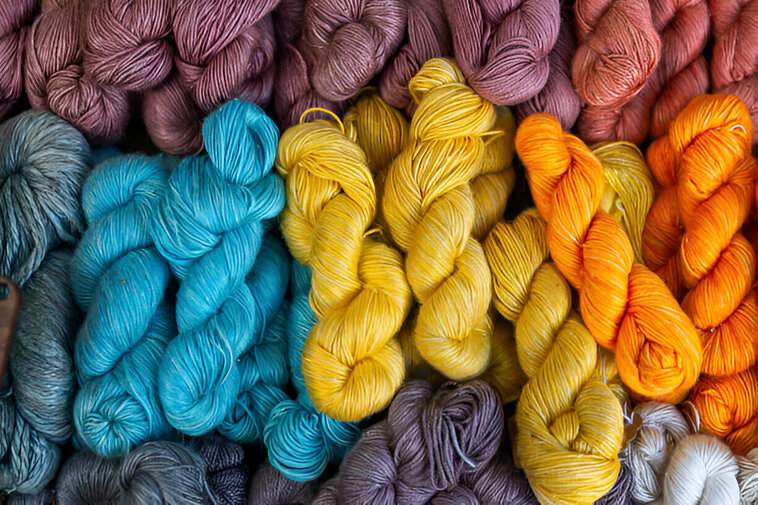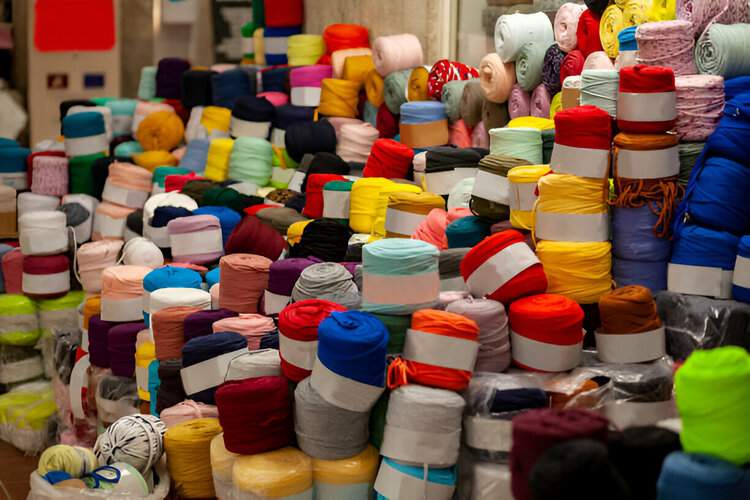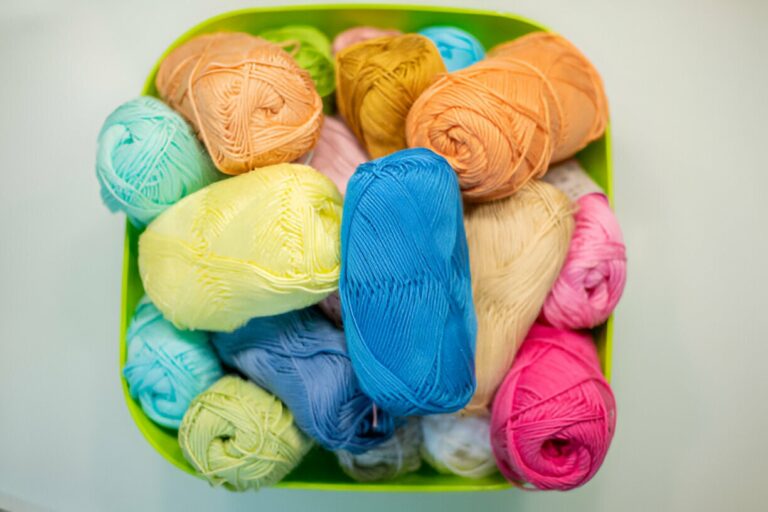Have you ever come across a picture of someone knitting or crocheting, and wondered what that colorful, loopy thing they’re using is? That is a skein of yarn! It’s the main ingredient in turning fluffy threads into cozy sweaters, stunning scarves, and adorable amigurumi (cute crocheted creatures).
This post is your one-stop guide to skeins of yarn. We’ll discuss how they compare to other yarn shapes, and answer all your burning questions about using them in your next crafting project.
Read Also: What is Yarn? Yarn Types & Weights Explained.
So, What is a Skein of Yarn?
A skein of yarn is a long strand of yarn loosely wound in an oblong shape.
Imagine a long, long strand of thread. Now picture it neatly coiled into a chubby oval shape, with the ends tucked somewhere in the middle. That’s a skein of yarn! It’s a way to store and transport yarn before it gets tangled into a frustrating mess.
Skeins vs Balls of Yarn: What’s the Difference?


You might also see yarn packaged in round balls. Both skeins and balls achieve the same purpose, keeping yarn tidy. But there are slight differences:
- Shape: Skeins are oval, while balls are, well, round!
- Pulling Yarn: You can usually pull yarn from the center of a skein (called “center pull”) or the outside. Balls are typically designed for outside pulling.
- Storage: Skeins might stack a little better on shelves, while balls can be easier to grab and go.
Read Also: How to Start a Craft Business in 10 Simple Steps.
Other Yarn Packaging / Shapes
There’s more to yarn packaging than just skeins and balls! Here’s a quick peek at some other shapes you might encounter:
Hanks: These are loose loops of yarn, often used for thicker yarns or hand-dyed varieties. They might need to be wound into a ball or skein before use.

Cakes: These pre-wound balls look like little cakes (because, why not?). They’re great for projects that require multiple colors because the yarn changes color in a planned sequence as you work.

How Much Yarn is in a Skein?
Just like skein size and weight vary, the amount of yarn in a skein can differ too. Typically, you’ll find skeins with anywhere from 50 to 450 grams (or about 1.5 to 1 pound) of yarn. But that doesn’t tell the whole story. Here’s the twist:
- Yardage matters more than weight: A skein of bulky yarn might weigh the same as a skein of fingering-weight yarn, but the bulky yarn will have fewer yards because it’s thicker. That’s why yardage estimates in patterns are so important!
How Many Yards in a Skein of Yarn?
As mentioned above, yardage is the total length of yarn in a skein. It’s usually displayed on the Yarn label along with the weight. Knowing the yardage helps you compare different skeins and estimate how many you’ll need for your project.
How Many Skeins of Yarn Do I Need for a Blanket?
This is a question every knitter or crocheter asks themselves at some point. The answer, unfortunately, isn’t a one-size-fits-all. It depends on a few factors:
- The size of your blanket: A baby blanket will obviously need less yarn than a king-sized masterpiece.
- The weight of the yarn: Thicker yarn covers more area than thinner yarn, so you’ll need fewer skeins of bulky yarn compared to a finer weight yarn for the same size blanket.
- The stitch pattern: Some stitch patterns use more yarn than others. Open, lacy patterns will gobble up yarn faster than solid ones.
The best way to figure out how much yarn you need is to follow a pattern. Patterns are like blueprints for your project, and they’ll usually tell you exactly how many skeins you’ll need. They might even give yardage estimates, which is the total length of yarn you’ll use.
How Much Does a Skein of Yarn Cost?
The price of a skein of yarn can vary greatly depending on the brand, fiber content (wool, cotton, etc.), and yardage. A basic acrylic skein might cost around $3, while a luxurious hand-dyed wool skein could be $20 or more.
We hope this post has given you a clear picture of the wonderful world of skeins of yarn! Now, grab a skein (or two!), pick up some needles or a crochet hook, and get ready to create something amazing!
Understanding the Yarn Math
There’s no one-size-fits-all answer to the yarn quantity question. It depends on a few key factors that work together like a well-oiled knitting machine:
- Project Size: This seems obvious, but it’s important! A scarf will obviously require less yarn than a king-size blanket. Grab your measuring tape and get those project dimensions ready.
- Yarn Weight: Remember how we talked about yarn weight in Part 1? Thicker yarn (like bulky) covers more area than thinner yarn (like fingering weight). So, for a project of the same size, you’ll need less bulky yarn than fingering weight yarn.
- The Knitting/Crocheting Pattern: This is your secret weapon! Most patterns will explicitly tell you how much yarn you need to buy. They’ll consider the stitch patterns used, the project size, and even account for a little wiggle room for error (because let’s be honest, sometimes mistakes happen!).
Read Also: What is Worsted Weight Yarn: Your All-Purpose Craft Companion.
Pro Tips for Yarn Shopping
Even with the magic of patterns, here are some extra tips to make yarn shopping a breeze:
- Project Planning is Key: Before you hit the yarn store with hearts full of crafting joy, read through your pattern carefully. The pattern will likely have a “yarn requirements” section that tells you exactly what you need.
- Buy a Little Extra (Just in Case!): It’s always better to have too much yarn than run out in the middle of your project! Why? Because different dye lots (batches of yarn) can have slight color variations. Buying extra from the same dye lot ensures a uniform look for your finished project. Imagine the heartbreak of finishing a scarf, only to realize the last bit of yarn doesn’t quite match the rest!
- Don’t Be Afraid to Ask for Help! Yarn store staff are crafters themselves, and they’re there to help you navigate the yarn jungle. Don’t be shy to ask them for advice on yarn quantities, color selection, or anything else that puzzles you.
Yards vs. Meters
While yarn is often sold in skeins, hanks, or cakes, the amount of yarn is typically measured in yards (in the US) or meters (most other countries). The good news is that most patterns will give yardage or meterage requirements, so you don’t have to worry about conversions.
The Joy of Leftovers!
So, you bought a little extra yarn, and now you have some leftover skeins? Don’t worry, leftover yarn is like crafting gold! You can use it for smaller projects like washcloths, potholders, or even cute little amigurumi toys (stuffed animals made with yarn).
Remember, the most important ingredient in any crafting project is your own creativity and enthusiasm. So, grab some colorful skeins, let your imagination run wild, and get ready to experience the magic of yarn!

